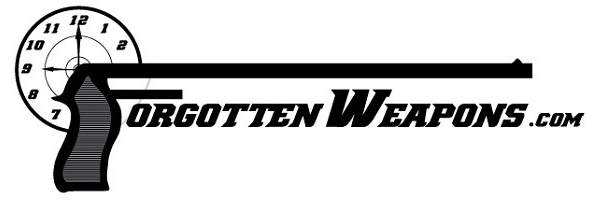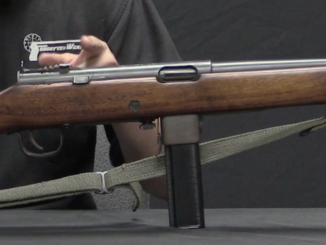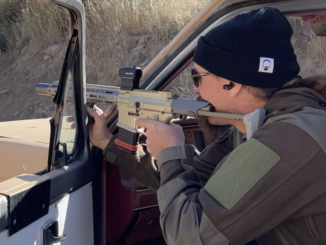Charles Sparrow Young was an extremely talent trap shooter around the turn of the century, sponsored by the Peters ammunition company. He was also a mechanical tinkerer, and developed several patents, including a shotgun release trigger. In 1901/2 he decided to design his own shotgun, and was granted two patents on it. The idea was to combine the best elements of both break action and repeating designs, and to make a product specifically tailored to trap shooting.
This meant that it would hold specifically two rounds, as that is what the game requires. Young’s design had a short receiver like a break action gun, and it cycled by pulling the barrel assembly forward. This ejected the fired shell and brought the second shell up from the bottom of the receiver to reload by sliding the barrel rearward again. The Young Repeating Arms Company was formed in 1901 to produce the guns. A four-story factory building was leased, and parts production began in 1902. Everything was to be done in-house, including barrel production and engraving, and the plan was to have about $20 invested in each gun and sell them for $75 and up. The marketing campaign to drive sales began in 1903…and then two weeks later the company went completely bankrupt.
After a couple of lawsuits and counter-suits, the company assets were liquidated. In 1904, the Sears Roebuck company purchased the whole affair for $8,000. Sears simply stripped the company of its useful assets, like tools and stock blanks to use for its own firearms division. About 125 guns were assembled from the parts that had been already manufactured, and these were sold in Sears’ 1905 catalog for just $15 each.




Any trap shooters out there that can give their opinion on whether Young’ design was of actual value to the sport?
This is the very definition of a niche product. It’s a clever design, but how many hard-core competition trap shooters are there out there who would buy one?
I think the market case for this sort of shotgun was a lot stronger back in the day than modern folks would think. Shooting sports used to be a hell of a lot more popular than we might expect, from today’s participation numbers.
Although, I think that there’s certainly an argument to be made that warping things such that you’ve wrapped the entire design of the shotgun around the needs of a specific sort of event might tend to lead to issues with commercial success. If you’re selling a two-round shotgun that’s focused on the game of skeet shooting, then when someone looks at it and says “Y’know… I like that, but I need something I can hunt with…”, you’re pretty much screwed from a marketing perspective.
I’d like a bit more detail on what went wrong with the whole thing, though… Did some backer pull funds? Was there a contributing economic downturn? Compared to a lot of “good idea” types, Mr. Young seems to have been rather better organized than most. Sad that he didn’t succeed.
Lots of rich men back then that would splurge on something like this. As Young was so well known, I would think he would have run the idea past other competitors to see what they thought before trying to start manufacturing.
For myself, I can see the advantage of the weight of one barrel over two barrels. Easier to aim and heft up all day. The downside would be speed to achieve second shot. I would think a double barrel model, with two triggers, would be faster on the second shot, over trying to cycle with by pumping.
Look at this video of someone shooting a Young. A bit of fumbling to get the second shot off. But maybe it just takes practice to get the rhythm right. Or the example was not complete, like Ian suggested.
https://www.youtube.com/watch?v=gxT_b74U3Is
There’s a group of small companies that market AR uppers that use reciprocating bolt handles on the side. For no reason except that allows one to quickly hand-chamber a single round, which is an advantage in some shooting sport that I’m not familiar with. The irony is, being so simple if that were mass-produced it should be cheaper than the AR we know, but of course it’s not cheap at all.
That’s the case for everything with the AR because of economies of scale, but Bear Creek does offer them for a very low price.
They have a low-tier reputation, but you could easily put a quality bolt and barrel into one for the same final price as a quality upper.
“(…)being so simple if that were mass-produced it should be cheaper than the AR we know, but of course it’s not cheap at all.”
This looks similar for TROY pump-action when compared to TROY self-loading rifle
https://worldoftroy.com/product/rifle-16-sporting-pump-223-std-trigger-troy-stock-optic-ready-blk/
https://worldoftroy.com/product/spc-a3-16-defender-forged-2/
former is $1140 compared to $999, even if does not need gas system at all
“(…)cycled by pulling the barrel assembly forward(…)”
This make it akin to later RMB-93 https://modernfirearms.net/en/shotguns/russia-shotguns/rmb-93-eng/
“(…)In 1901/2 he decided to design his own shotgun(…)”
Was it designed for (back-then) well-established black-powder or new-fangled smoke-less powder?
“(…)Sears Roebuck company(…)”
At that time it identified as Sears,Roebuck
and C0· see title page at https://archive.org/details/catalogueno11200sear
and they sell… basically everything.
“(…)sell them for $75 and up(…)”
For comparison, some prices from above catalog
Winchester Model 1901 Lever Action Shotgun $21.47
Fancy Marlin Take Down Repeating Shotgun for $30.00
Top notch info, again.